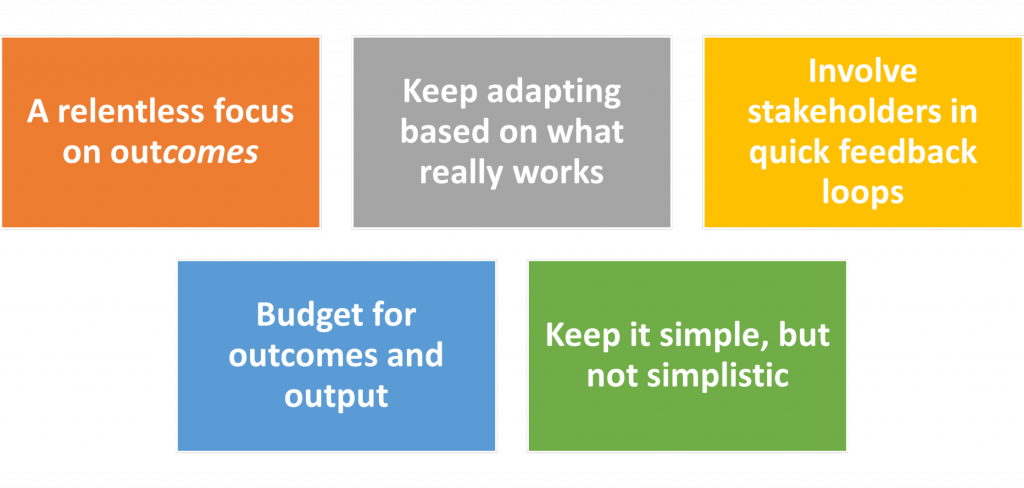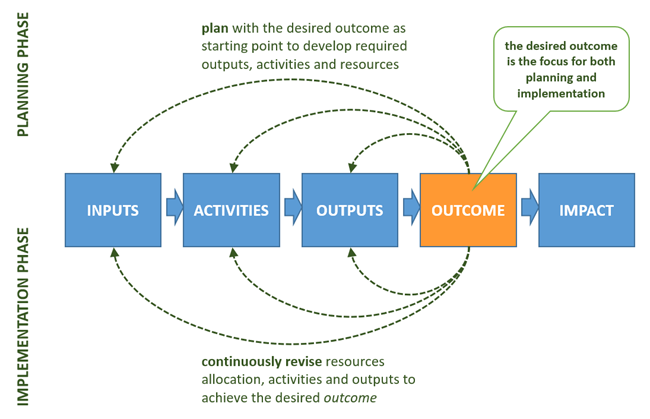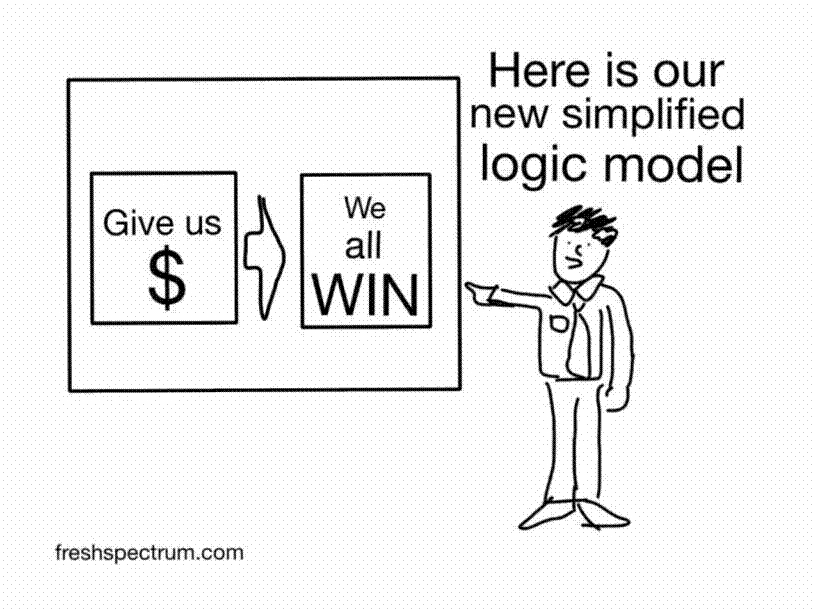Results Based Management can be effective, powerful approach. However, there are five basic rules. If you are a planner, an M&E specialist or consultant or a manager, read on. Let me know if you agree.

- A relentless focus on outcomes, outcomes, and outcomes
- Keep adapting what you do based on what you learned from outcome monitoring
- Involve stakeholders at every step to create quick feedback loops
- Budget for outcomes and outputs, not for activities
- And overall: keep RBM simple, but not simplistic
Rule 1: Outcomes are the only game in town
At least one thing about Results Based Management should be clear: A focus on resources (=inputs), activities and outputs does not tell us about any real changes we makes in the lives of people. It is the old ways of concentrating on ‘spending money and doing things’, rather than focusing on the benefits, if any, that results from what we are doing.
Defining ‘results’ as outputs, outcomes and impact naturally raises the question: Which of these three results levels is the most important from a RBM perspective? Ask yourself: If you had to choose only one, which level in the results chain would you select for planning, monitoring, reporting and evaluating?
The answer is easy: outcomes. Outcomes are – from almost every perspective, the concerned person, the organisation, the government, the donor – what ultimately counts.
Why not focus on outputs?
Why not outputs? Indeed, much of the current planning, monitoring, reporting is focus on outputs: have they all been delivered, have they been delivered without delays, in good quality, etc. However, that misses the point of Results Based Management.
Sheila B. Robinson formulated that nicely: ‘Outputs are for programmes, outcomes are for people‘. What did she mean? Outcomes are ultimately always about people: people who do something different or better in the future (behavioural change or change in performance). Outputs, on the other hand, are less ambitious and not about changing people’s performance or behaviour. They typically refer to the fact that a group of people or an organisation has improved capacities, abilities, skills, systems, policies or if something is built, created or repaired – but not necessarily about people doing something different or better in the future.
Why not focus on impact?
But why not focus on managing for impact instead? My argument is: While a vision of the desired impact is certainly important, managing for impact is unrealistic most of the time. For example, if we work towards higher employment of marginalized groups, a better health outcome for covid-19 patients, the restauration of wild life, a more sustainable transport system, we simply don’t have the time to wait if it works out what we do. The desired impact typically takes too long to expect that we can adjust and correct our interventions in time.
So, outcomes are the only game in RBM town. They are at the very core of RBM. A radical focus on outcomes has the advantage that we concentrate all efforts on changes in behavior or performance which make a difference in the lives of those people we intend to support. And on the other hand, expected outcomes remain so intricately linked to our interventions that we can still credibly show that we at least significantly contributed to these positive changes.
Rule 2: Keep adapting based on outcome monitoring
Managing for outcomes requires a highly adaptive approach. It is sometimes referred to as ‘adaptive management’. This requires us to do two things:

We must be very clear and specific when defining the outcome we want to achieve. We also need effective measurements to track the extent we are progressing towards the outcome.
On the other hand, we must be sufficiently flexible to constantly review and change elements in the results chain that are not outcomes: outputs, activities and inputs. Only such an approach allows us to adapt what we do to ensure that we are progressing towards our desired outcome.
Rule 3: Involve stakeholders. Always.
We must involve those that have a stake in what we try to achieve (=’stakeholders’) at every step. We need to have them on board when planning, when monitoring, when evaluating, and when reporting. And this is not just to be nice and ‘participatory’: it simply makes our programme, project, policy or service better.
Involving stakeholders at every step is also a logical consequence from a laser sharp focus on outcomes: These stakeholders are often the first (and best) to find out somebody does something different or better – that is if their own performance or behaviour has changed. In that sense, stakeholders are the real experts. We can’t manage for results without them!
OK, so who are those stakeholders? Well, the typically include:
Most importantly, those people who are expected to change their behaviour or to improve their performance (= the ‘beneficiaries’, ‘clients’, ‘users’)
People who may experience negative consequences from a programme, project, policy or service
People with decision making authority
Organisations that implement similar or potentially conflicting interventions
Rule 4: Budget for outcomes and outputs
Results based budgeting establishes a link between budget allocations to specific outputs – and particularly to progress towards outcomes. Results based budgeting is a subset of RBM. Now, how do we establish that link between budgets and results? We can do that in several ways:
We shift accountability from inputs and activities to deliver outputs and achieve outcomes. Managers should not only be responsible for spending a certain amount of money or for carrying out a set of activities. Instead, they should be accountable for delivering outputs – and especially for progressing towards and achieving outcomes.
Linked to that, we reward managers to successfully deliver outputs and achieve outcomes, instead of incentives to spend resources and carry out activities.
We closely track value-for-money that links monitoring to budget data. This leads to calculations like ‘How much does it cost to deliver an output?’ or ‘How much are we paying towards achieving an outcome?’.
That of course also means that managers must have much more authority to continuously reallocate resources for better performance.
Rule 5: Keep it simple

There is a certain risk that Results Based Management is turned into a complex, rigid and overly technical approach. No, no and no. Let me repeat myself: RBM must not make life more difficult, on the contrary.
RBM is about striking the right balance between keeping things simple and clear – while avoiding oversimplification (like in the cartoon above).
The laser sharp focus of true Results Based Management on outcomes helps to keep things simple. Further, we can do a few more things about it.
– using a clear, concise language free of jargon
-limiting the number of outcomes and outputs in our results chains
-measuring progress and success sensibly using a limited number of well-chosen indicators
In a nutshell
Results Based Management can be an effective, powerful and practical management approach. For true RBM, we must keep a relentless, laser sharp focus on outcomes, keep adapting what we do based on what we learn from outcome monitoring, involve stakeholders at every step to create quick feedback loops, budget for outcomes and outputs, and keep it simple, but not simplistic.
Want to know more?
Enrol in our free crash course on Practical Results Based Management at the Results Lab.

